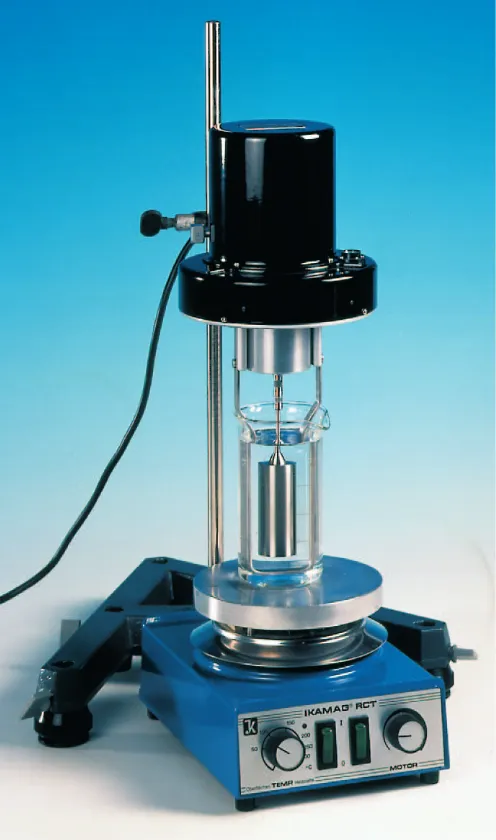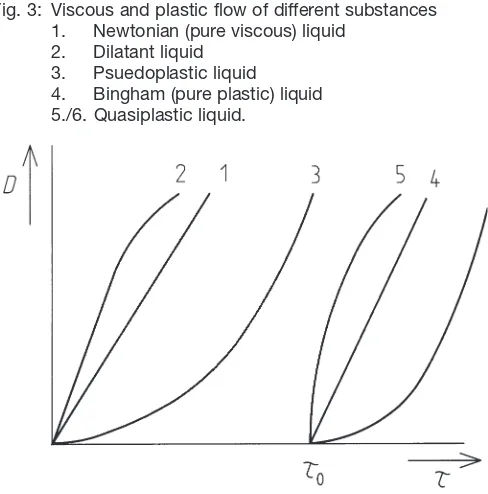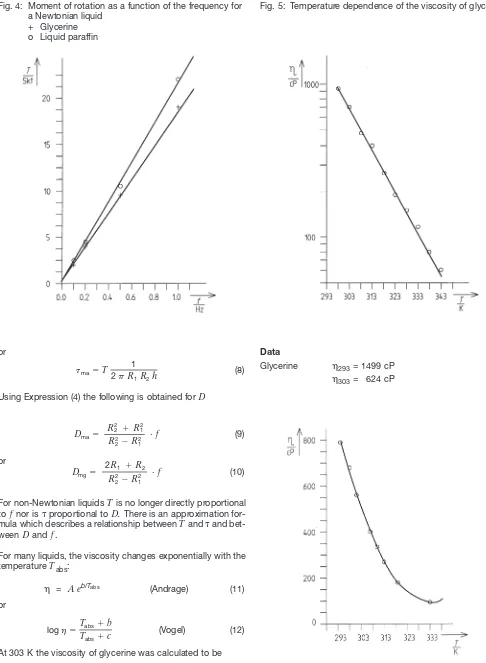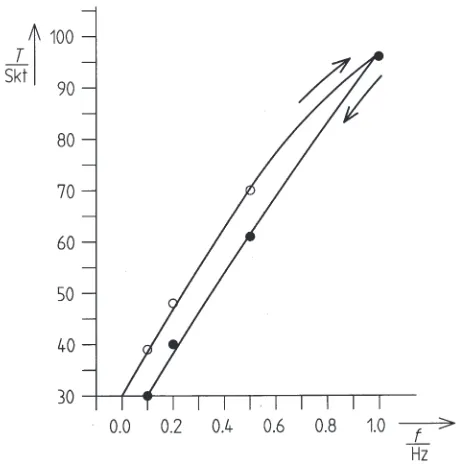Viscosity of Newtonian and non-Newtonian liquids (rotary viscometer) 1.4.03-00
Principle:
The viscosity of liquids can be deter-mined with a rotation viscometer, in which a motor with variable rotation speed drives a cylinder immersed in the liquid to be investigated with a spiral spring. The viscosity of the liq-uid generates a moment of rotation at the cylinder which can be meas-ured with the aid of the torsion of the spiral spring and read on a scale.
Temperature dependence of the viscosity of castor oil.
Tasks:
1. Determine the gradient of the ro-tational velocity as a function of the torsional shearing stress for two Newtonian liquids (glycerine, liquid paraffin).
2. Investigate the temperature de-pendence of the viscosity of Cas-tor oil and glycerine.
3. Determine the flow curve for a non-Newtonian liquid (chocolate).
Rotary viscometer 18221.93 1
Support base -PASS- 02005.55 1
Support rod, stainl. steel, l= 500 mm 02032.00 1
Right angle clamp 37697.00 1
Magn. heating stirrer w. temp.con 35720.93 1 Magn.stirring bar l= 30 mm, cyl. 46299.02 1 Separator f. magnetic bars 35680.03 1 Glass beaker, short, 600 ml 36015.00 3 Glass beaker, tall, 250 ml 36004.00 2 Glass rod, boro 3.3, l= 200 mm, d= 5 mm 40485.03 1
Digital thermometer 07050.00 1
Immersion probe NiCr-Ni, -50/1000°C 13615.03 1
Glycerol, 250 ml 30084.25 2
Liquid paraffin, 250 ml 30180.25 1
Castor oil, 250 ml 31799.27 2
Acetone, chem. pure, 250 ml 30004.25 3
What you need:
Complete Equipment Set, Manual on CD-ROM included
Viscosity of Newtonian and non-Newtonian
liquids (rotary viscometer)
P2140300
What you can learn about …
Shear stress
Velocity gradient
Internal friction
Viscosity
Related topics
Shear stress, velocity gradient, internal friction, viscosity, plas-ticity.
Principle
The viscosity of liquids can be determined with a rotation vis-cometer, in which a motor with variable rotation speed drives a cylinder immersed in the liquid to be investigated with a spi-ral spring. The viscosity of the liquid generates a moment of rotation at the cylinder which can be measured with the aid of the torsion of the spiral spring and read on a scale.
Equipment
Rotary viscometer 18221.93 1
Support base -PASS- 02005.55 1
Support rod, stainl. steel, l= 500 mm 02032.00 1
Right angle clamp 37697.00 1
Magn. heating stirrer w. temp.con 35720.93 1 Magn.stirring bar l= 30 mm, cyl. 46299.02 1
Separator f. magnetic bars 35680.03 1
Glass beaker, short, 600 ml 36015.00 3
Glass beaker, tall, 250 ml 36004.00 2
Glass rod, boro 3.3, l= 200 mm, d= 5 mm 40485.03 1
Digital thermometer 07050.00 1
Immersion probe NiCr-Ni, -50/1000°C 13615.03 1
Glycerol, 250 ml 30084.25 2
Liquid paraffin, 250 ml 30180.25 1
Castor oil, 250 ml 31799.27 2
Acetone, chem. pure, 250 ml 30004.25 3
Tasks
1. Determine the gradient of the rotational velocity as a func-tion of the torsional shearing stress for two Newtonian liquids (glycerine, liquid paraffin).
2. Investigate the temperature dependence of the viscosity of Castor oil and glycerine.
3. Determine the flow curve for a non-Newtonian liquid (cho-colate).
Set-up and procedure
The experimental set-up is presented in Fig. 1. The rotary vis-cometer must be adjusted until it is exactly vertical. Use the adjustment screws to do this: they are located on the base of the support stand. There is a box level on the viscometer which allows one to check the exactness of the set-up’s adjustment.
Screw the rotary cylinder on carefully (left-handed threads). Subsequently, lower the viscometer until the surface of the liquid exactly reaches the calibration mark on the rotary body in each case. Stir low viscosity fluids while heating to the de-sired measuring temperature with the aid of a magnetic stirrer and a magnetic stirring rod to rapidly achieve a uniform heat distribution. The temperature should always be measured in the immediate vicinity of the immersion cylinders. After the experimental temperature has been reached, turn off the heat-er. The temperature should remain constant for several minu-tes before measurements are begun, as the immersion cylin-der must be in thermal equilibrium with the liquid. When ther-mal equilibrium has been reached, switch off the magnetic stirrer and determine the viscosity of the liquid. Since the moments of rotation which are measured in this experiment are very small, it is necessary to study the operating instruc-tions of the rotary viscosimeter carefully and to follow them exactly.
After the measurement has been made, always clean the bar of the viscometer and the rotary cylinder carefully with water or acetone.
For glycerine and liquid paraffin, determine the dependence of the moment of rotation on the frequency in the range between 0.1 Hz and 1.0 Hz.
For glycerine and castor oil, determine the dependence of the viscosity on the frequency in the temperature range between approximately 290 K and 350 K. For chocolate, determine the dependence of the moment of rotation of the frequency in the Fig. 1: Experimental set up: Viscosity of Newtonian and
range between 0.1 Hz and 1.0 Hz at a temperature of approx-imately 303 K.
Other substances which are appropriate for investigation are: Newtonian substances: oils, ethylene glycol, etc.
Non-Newtonian liquids: paints (structural colour, hammer effect enamel), syrup, lubricants, chocolate spread, etc.
Theory and evaluation
If a liquid is between two plates and a force Facts along the plate in the direction of the x axis, the plate moves with veloc-ity v. For Newtonian liquids the corresponding component of the shearing stress t
(1)
is linked with the velocity gradient as follows:
(2)
(
I
is the viscosity of the liquid and Athe area of contact be-tween the plate and the liquid.)A number of substances (suspensions, emulsions) show a complex correlation betweenTand the integral velocity gradi-entD(non-Newtonian liquids). Hysteresis is also possible.
Rotary viscometer
A rotary viscometer consists of an inner and an outer cylinder. The liquid to be investigated is located between them. At low rotational velocity the moment of rotation which is exerted on a cylindrical layer of liquid with a radius rand a height h
con-forms to the following relationship as a result of the rotation of the outer or inner cylinder:
T(r) =
U
· 2Q
r h· r (3)The shearing stress can be expressed by the measurable moment of rotation:
(4)
In this case, the velocity gradient Dis as follows:
(5)
W
is the angular velocity.For Newtonian liquids eqn. (2) or eqn. (3) can be substituted in eqn. 1. Integration with the following limiting conditions:
W
= 0 for r= R1W
=ffor r= R2(R1 and R2 are the radii of the two cylinders) gives the
follow-ing relationship between the measured moment of rotation and the angular velocity:
(6)
where Cis a device constant.
The above expression must be further corrected due to edge effects so that C becomes an empirical constant.
It is customary to use the average shearing stress acting on the surface of the two cylinders (2), which is obtained from the geometric or arithmetic mean of the shearing stresses (
U
mgorU
ma).Fig. 2: Velocity gradient and shearing stress.
Fig. 3: Viscous and plastic flow of different substances 1. Newtonian (pure viscous) liquid
or
(8)
Using Expression (4) the following is obtained for D
(9)
or
(10)
For non-Newtonian liquids Tis no longer directly proportional to fnor is
U
proportional to D. There is an approximation for-mula which describes a relationship between TandU
and bet-ween Dandf.For many liquids, the viscosity changes exponentially with the temperature Tabs:
I
= A eb/Tabs (Andrage) (11)or
(Vogel) (12)
At 303 K the viscosity of glycerine was calculated to be
I
= 680 cPData
Glycerine
I
293= 1499 cPI
303= 624 cPlog hTabsb
Tabsc
Dmg
2R1 R2
R2 2R21
· f Dma
R2 2 R21
R2 2R21
· f
tmaT
1 2 pR1R2h
Fig. 5: Temperature dependence of the viscosity of glycerine. Fig. 4: Moment of rotation as a function of the frequency for
a Newtonian liquid + Glycerine o Liquid paraffin



